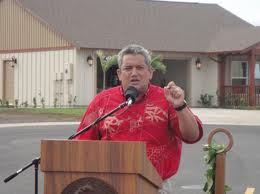“Sustainability is about living with aloha” -Mayor Billy Kenoi
Geothermal energy, wind, sunshine, good soils, and a great aquifer system have the Big Island of Hawaii feeling good these days. Billy Kenoi, mayor of Hawaii County, touted the county’s accomplishments in a recent speech at the TechConKona Conference, in which Paul Hawken keynoted.
‘The big question for the big island of Hawaii is “what is our energy future?”‘ said Kenoi. Kenoi rattled off a list of challenges facing the big oil producers. Syria is facing a turmoil that tops the list, Egypt just elected a president who is part of the Muslim brotherhood, an untested political entity, Iran and Israel continue to ramp up their diplomatic standoff, and no one knows what’s going to happen in Iraq.
The crises across the middle East are relevant to the big island because, as with the rest of Hawaii, foreign oil is the primary source of energy, providing more about 90% of the electricity for Oahu, where the majority of Hawaii’s residents live.

In addition, there are economic challenges. At the moment, the visitor industry accounts for the 6 biggest employers on the island. Kenoi said, “Recent visitor statistics have been positive but can we continue to rely on this?” He remarked that they’ve made a legitimate, not a nostalgic, effort to pursue increased agricultural capacity here on the island, and employment in ag is growing to a point where it’s higher than at any time since 1994. But the average age of a farmer on the the island is 59.
“We gotta honor the farmer,” said Kenoi. “We have great aquifers, but without the energy, it is difficult for water to be affordable for farmers.” Hawai’i currently has the nation’s most expensive electricity, with rates over 40 cents per kilowatt.
To combat the issue, Hawaii island’s renewable energy mix has grown impressively. Currently, according to Kenoi, the island derives 49% of its power from renewable energy, mostly geothermal, a plentiful resource here in the volcanic islands. The cost of electricity are still too high, mainly due to the use of foreign oil still creating a majority of electricity here, and a grand majority on the other islands, where geothermal is not quite as plentiful.
Renewable energy is about the future, and the future is about our kids. Kenoi finished by saying, “How do we give our kids hope without putting emphasis on renewables?”
Amen brother. Amen.
A shameless plug: I developed a sustainability board game and card game based on the transition of Hawaii to a sustainable future. Check it out if you like games: www.GBOHawaii.com.
Follow Scott Cooney and Inspired Economist on Twitter. You know…if you want to.


